In this post, I’ll discuss the must-have features to keep in mind when choosing your internal help desk, plus the best internal ticketing systems that check all those boxes. In addition, I’ve put together a list of other IT support software you might also be interested in. Let’s go!
Table of Contents
- Internal Ticketing System
- Internal IT Ticketing System Features
- Best Internal Help Desk Ticketing Software
- Best IT Support Software
- Internal Ticketing System Benefits
- Improve Support With Internal Help Desk Software
Internal Ticketing System
An internal ticketing system is used to handle support requests inside an organization. When employees run into problems with their tools, they submit a ticket, which creates a digital record and alerts IT for help.
Internal ticketing systems formalize your internal support process, making it easier to track open cases and reducing the time your employees have to wait to resolve their issues.
Pro Tip: HubSpot's Ticketing System tracks customer inquiries from multiple channels in one location.
An internal ticketing system automatically notifies the IT team whenever an employee creates a new case. Additionally, employees can create new IT support cases from their computers, saving them the need to physically walk over to IT every time their inbox acts up.
Another significant benefit of an internal ticketing system is organization. Since you'll have a digital record of every inquiry filed with your team, losing or forgetting an open case is nearly impossible.
Some ticketing systems even have automated notifications that alert your team whenever a conversation on an open ticket goes silent. With safeguards like these, IT teams can work confidently, knowing they're on top of their support inbox.
Now that we‘ve covered an overview of internal ticketing systems, let’s review some of their benefits in the section below.
Internal IT Ticketing System Features
In my experience, an internal IT ticketing system helps your support team document technical problems using tickets. Designed to meet ITIL standards, the main goal of an internal IT ticketing system is to restore service operations to normal as quickly as possible and prevent significant disruption to business operations.
Tickets contain details of service requests, their priority, status, and other relevant information. Your team no longer needs to comb through hundreds of messages. Instead, cases can be organized and triaged to speed up resolution.
Plenty of IT ticketing systems may fit your needs, but there are some essential features I suggest you look for during your selection.
1. Omni-Channel Support
Creating and submitting a service request should be easy. Users should be able to report issues through multiple contact points and receive support via the channel they prefer most. These channels include email, social media, live chat, phone, walk-ups, or the help desk itself, depending on what works best for your users.
Omni-channel support ultimately enhances the support experience while keeping your IT team organized. Users don't have to navigate away from their work, and the IT team can handle all requests from a centralized location.
2. Ticket Assignments
To manage your ticket inflow successfully, I’ve found that your team must know where and how to distribute tickets to the right people. Your ticketing system should have features that let you categorize, prioritize, and assign tickets to other employees.
For example, tickets can be categorized by issue type, priority, and department.
Ticket assignments automate your team's case distribution and assign service requests to reps with more knowledge about a particular issue. I guarantee that connecting users with the right employee to solve their problems will increase case resolution rates and satisfaction of both the IT team and the rest of your employees
Pro Tip: HubSpot's Automated Ticket Routing streamlines support processes by directing tickets to appropriate agents.
3. Workflow Automation
Workflows are predefined processes that automatically complete everyday tasks and boost team productivity. They can consist of macros, SLAs, automation rules, bots, and third-party integrations that handle menial actions so your team can take on more complex, higher-priority issues.
For example, you can set an automation rule to tag issues containing specific keywords or notify an agent when an issue is assigned to them.
If your organization uses additional apps for sales, finance, or human resources, you can integrate these tools into your workflows to update records elsewhere or trigger updates within your system.
4. Reporting and Analysis
By pinpointing the source of common issues, you can address major challenges that impact daily operations. When I worked in support, we used reports and dashboards to keep track of rep performance and gain an understanding of the issues customers encountered most frequently. Your internal help desk operates the same way from a conceptual standpoint, except the customers are your company's employees.
Understanding analytics and trends will inform you how to allocate time and resources, make staffing decisions, and more. Any internal help desk worth its salt should have robust reporting features.
5. Personalized Customer Pages
A chronological record of each customer’s help desk interactions is an invaluable time-saving feature. Instead of starting from scratch with each ticket, your internal help desk should maintain a timeline and record of all past cases, notes, and resolutions to give context to the case at hand.
When I worked as a support rep, I referred to the customer timeline daily. It was beneficial to see which of my colleagues a customer previously worked with. That way, I could reference past cases, saving the customer the need to reiterate details of past support interactions. In addition, I knew which of my teammates to reach out to for additional context or assistance on a tough case.
6. Knowledge Base
Customers love self-service, with 40% of users reporting a preference for self-service options over direct support. Self-service empowers customers to resolve issues independently, typically saving time compared to directly working with your IT team.
As a support representative, I often referred customers to knowledge base articles to help solve their issues. For the most part, customers appreciated having the resources to help themselves in the future. This saved everyone time and made customers feel empowered and fulfilled using our product.
Knowing how busy your employees are, an internal knowledge base can allow users to find the answers and instructions they need independently. Not all IT ticketing systems come with this option, but it's certainly a feature to consider as your organization grows.
Best Internal Help Desk Ticketing Software at a Glance
|
CRM |
HubSpot Help Desk |
SysAid |
Solarwinds |
HappyFox |
|
Key Features |
Built on HubSpot's CRM platform, drag-and-drop pipeline management, customer feedback tools, automation and bots, knowledge base for internal documentation, all-in-one business platform |
Generative AI Co-pilot assistant, self-service portals, knowledge base capabilities, comprehensive support inbox, ITSM platform for IT technicians |
ITSM platform with full service desk management, customizable service portal, automation rules for ticket routing, AI assistant for recommended next steps, database and network management solutions, asset and change management |
Color-coded interface, multiple ticket views, email and support center ticket creation, automatic categorization and assignment, asset management on premium plan, multiple app integrations |
|
Pricing |
Free plan available, Starter $15/user/month, Professional $90/user/month, Enterprise $150/user/month |
Available upon request |
Essentials $39/user/month, Advanced $79/user/month, Premier $99/user/month |
Basic $9/user/month, Team $49/user/month, Pro $99/user/month, Enterprise pricing upon request, unlimited user pricing available |
|
Free Trial |
Yes (Free plan) |
Yes (free trial mentioned) |
Yes (demo mentioned) |
Yes (demo mentioned) |
Best Internal Help Desk Ticketing Software
- HubSpot Help Desk and Ticketing Software
- SysAid
- Solarwinds
- HappyFox
- ProProfs Help Desk
- Jira Service Desk
- Mojo IT Helpdesk
- Freshservice
- Spiceworks Cloud Help Desk
- Vision Helpdesk
- Giva
- ServiceDesk Plus
- TOPdesk
- Atera
- Servicenow
Now that you know what to look for in an IT ticketing system, let‘s examine my picks for this year’s best options.
1. HubSpot Help Desk and Ticketing Software
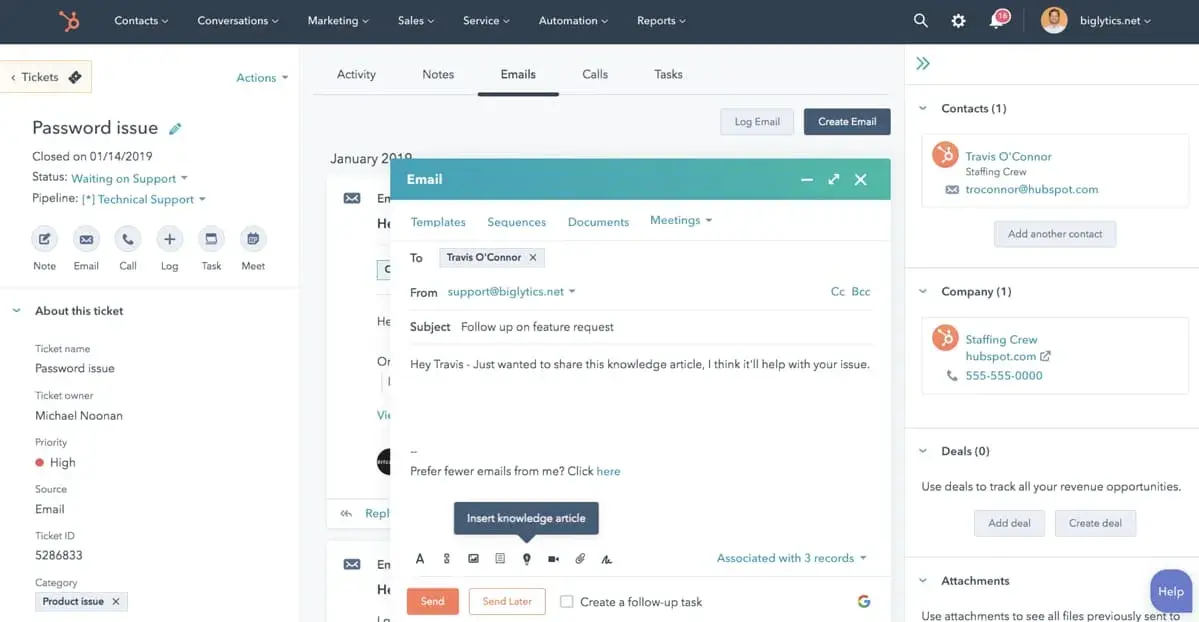
Start Using HubSpot's Internal Internal Help Desk Ticketing Software for Free
Best for: Small businesses new to ticketing software and enterprises looking to streamline help desk operations.
What I like: It’s user-friendly, efficient, and built on HubSpot’s CRM platform, which provides a central place to store all customer information.
Pricing:
- Free plan available
- Starter: $15/user/month
- Professional: $90/user/month
- Enterprise: $150/user/month
HubSpot's Service Hub is service management software that helps you onboard customers, power flexible customer support, and expand customer relationships. It delivers efficient and end-to-end service that delights customers at scale.
Using HubSpot Service Hub, you can set up a company email alias for IT support or a knowledge base for internal documentation, ensuring that service information is readily available for every IT team member.
You'll also have access to customer feedback tools to survey and proactively measure customer sentiment. Additionally, all incoming requests convert to tickets and are managed in a drag-and-drop pipeline.
Automation, bots, and integrations improve the tool‘s flexibility and ability to meet your customers’ needs. Since it's built on HubSpot's all-in-one CRM platform, you'll have more context for every customer conversation, and all customer data will be up-to-date and centrally located.
As a former HubSpot support rep and current user, I have to admit that I’m a little biased. However, I think it’s undeniable how feature-rich and easy-to-use the platform is. My favorite thing about HubSpot is that you can use it to run your entire business, from internal ticketing to CRM, email, website management, invoicing, and more.
Pro tip: Use HubSpot's Help Desk and Ticket Automation Software to track all customer requests and keep your team organized so reps can prioritize work and provide quality customer support faster.
2. SysAid
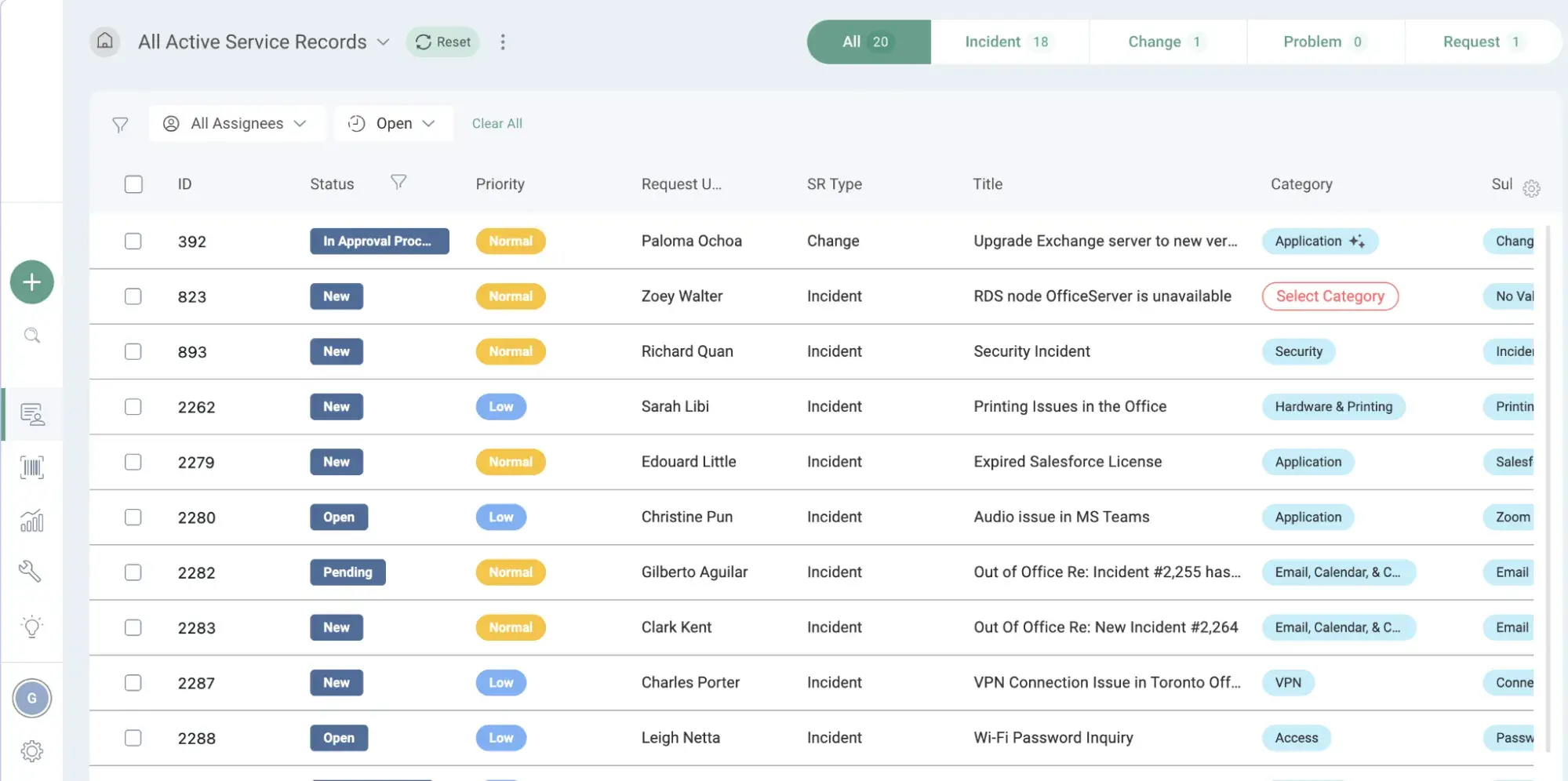
Best for: Taking advantage of generative AI to save time in IT support.
What I like: SysAid has a whole host of self-service features to empower end users to solve issues independently.
Pricing: Available upon request.
SysAid is an Information Technology Service Management (ITSM) and help desk platform that empowers IT technicians to help users and users to help themselves. I tried SysAid for a free trial and was impressed with its comprehensive support inbox and self-service portals.
It also features knowledge base capabilities so employees can help themselves, and an AI assistant feature dubbed “Co-pilot” can reference your knowledge base and company assets to deliver accurate information instantly.
3. Solarwinds
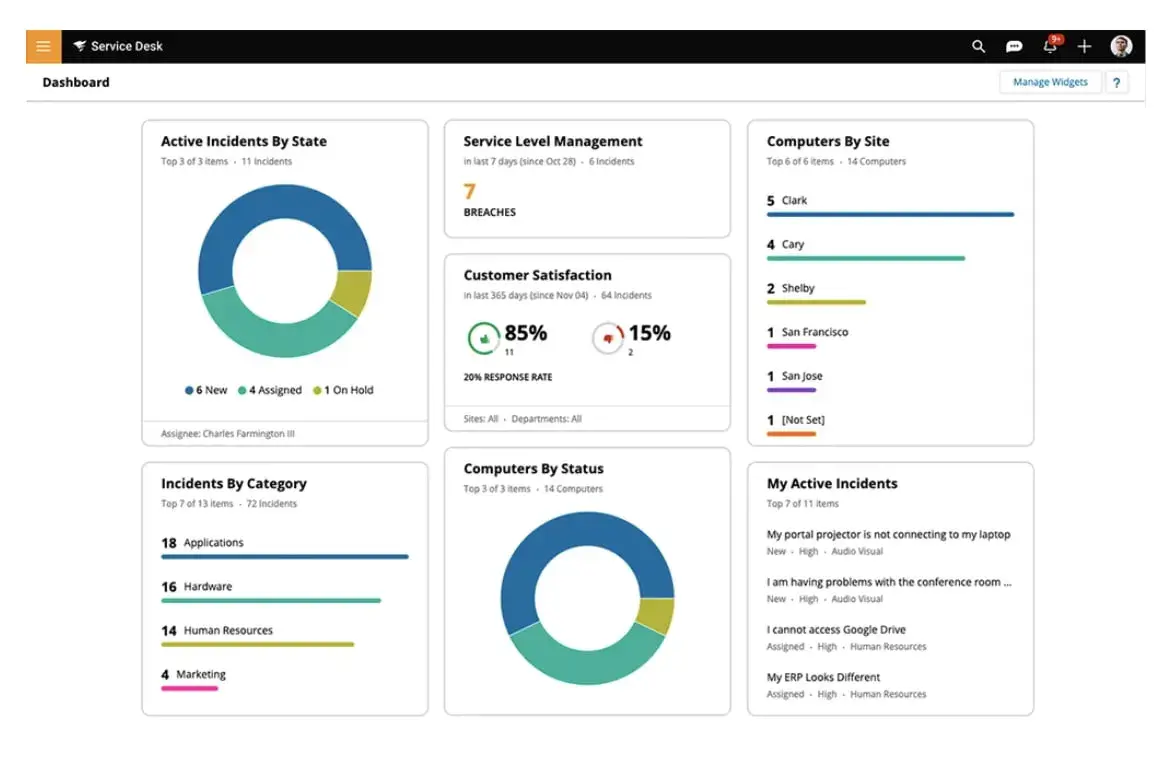
Best for: Large enterprises and companies looking to transition from IT software to a full-service desk management system.
What I like: Solarwinds also offers Database and Network Management solutions, making it a one-stop shop for IT needs.
Pricing:
- Essentials: $39/user/month
- Advanced: $79/user/month
- Premier: $99/user/month
SolarWinds is an ITSM platform that helps support teams capture requests, resolve issues, and deliver services reliably across the organization.
A flexible service portal lets employees file requests and report issues quickly. You can also configure automation for routing and approvals, as well as set up workflows for problem, asset, and change management.
Solarwinds lets you document and publish standard processes and best practices in a knowledge base. Users can then reference these articles to solve problems independently, and agents can insert them into their responses for faster resolution.
I did a demo of Solarwinds, and I was particularly impressed with the AI assistant feature. This feature automatically generates recommended next steps for reps based on the initial request and information within the ticket. Reps should always review each ticket themselves, but the AI assistant feature can help you quickly identify common requests to save time.
4. HappyFox
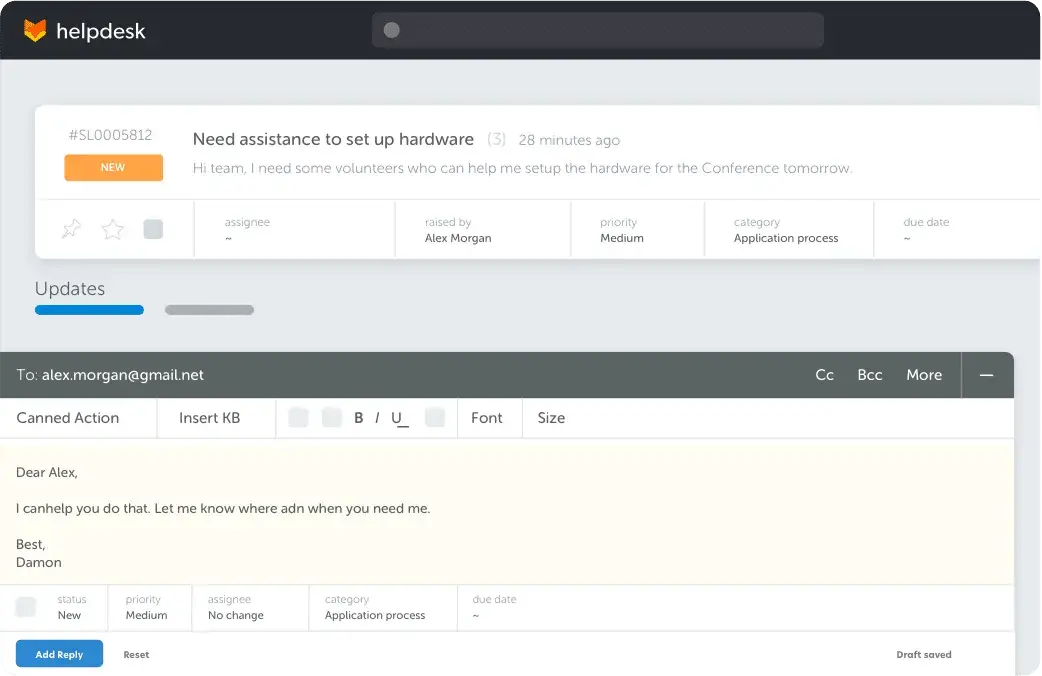
Best for: Small- to medium-sized businesses looking for a simple IT help desk solution that can also serve as an external support tool.
What I like: The color-coded interface makes it easy for first-time ticket management users to navigate through assigned tasks. It also integrates with numerous apps, such as Shopify, Slack, and WhatsApp.
Pricing:
- Basic: $9/user/month
- Team: $49/user/month
- Pro: $99/user/month
- Enterprise: pricing upon request
Alternative pricing for unlimited users is also available.
HappyFox lets agents receive and create tickets via email or through a customizable support center, so you can manage issues regardless of where they were reported. Tickets are displayed on the “Ticket List” page, with layout options like “Card View” or “Kanban View,” so your agents can better understand the current workload.
If you adopt the premium plan, HappyFox lets you create and manage assets within your organization, while linking them to tickets when relevant.
During my demo of HappyFox, I was impressed with its ability to automatically categorize and assign employee-generated tickets based on a predefined set of rules. For example, you can tell HappyFox to assign issues regarding employee laptops to a particular technician automatically. Meanwhile, keycards and building access issues can be automatically assigned to a separate tech specializing in that area.
5. ProProfs Help Desk
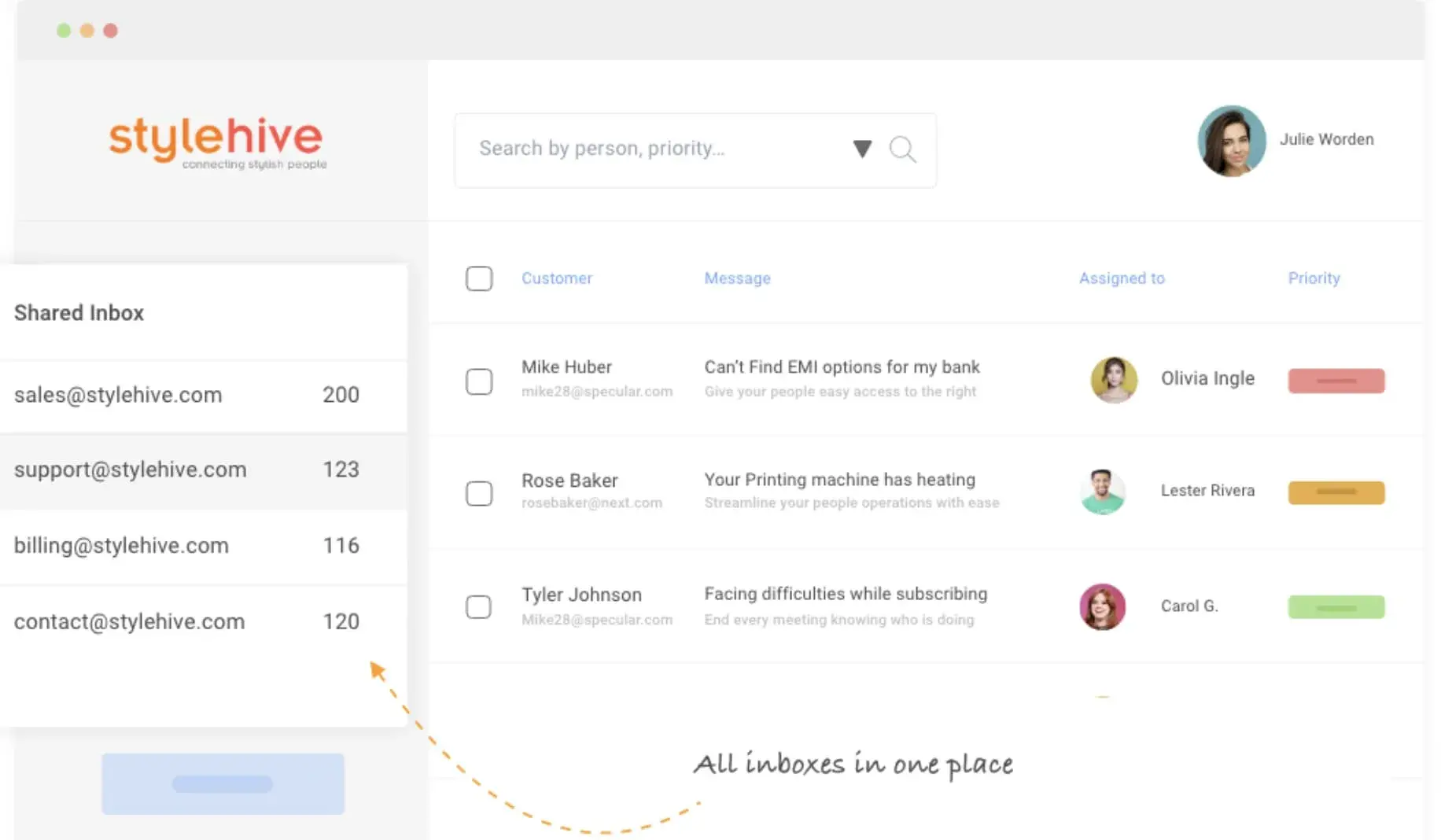
Best for: Small- to medium-sized businesses wanting a cost-effective internal help desk solution with intuitive and effective features.
What I like: ProProfs stands out for its simplicity and ease of use. I like that ProProfs offers a free plan for startups and micro-businesses, and I found that platform intuitive, especially for first-time help desk users.
Pricing:
- Free plan available
- $19.99/user/month
ProPros Help Desk is an internal ticketing system that helps your team manage your incoming internal support requests from a shared inbox. ProProfs includes many helpful features, such as:
- Intelligent AI ticket assignment.
- Internal knowledge base.
- Live chat.
- Reporting and analytics.
ProProfs is an excellent combination of simplicity and functionality at a great price. If you’re looking for a highly customizable solution to fit an enterprise with complex needs, you may want to look elsewhere. However, I think the majority of small- to medium-sized businesses would be well-served by the ProProfs Help Desk.
6. Jira Service Desk
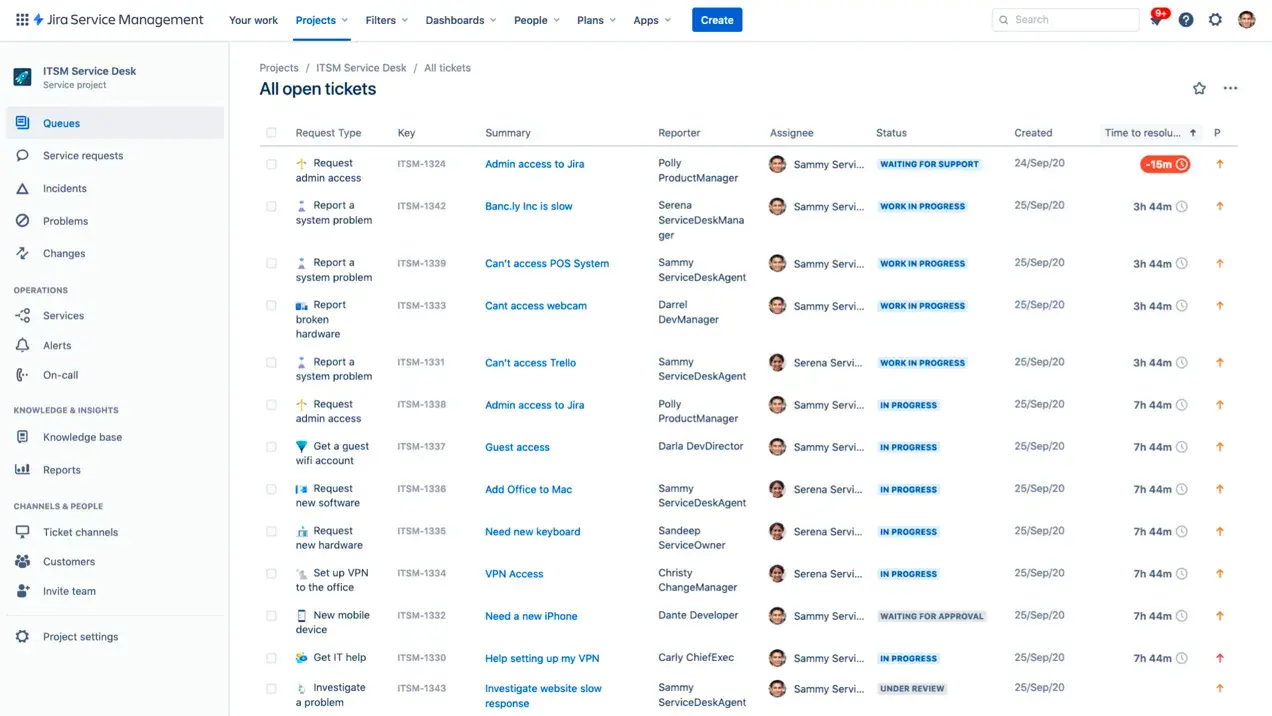
Best for: Large enterprises that receive a high volume of internal requests daily and engineering departments needing to streamline internal processes.
What I like: Jira seamlessly links support and development teams to solve issues quickly and inform future software fixes.
Pricing:*
- Free plan available
- Standard: $22.05/user/month
- Premium: $49.35/user/month
- Enterprise: pricing upon request
*The price per user/month decreases as the team size increases. The prices above are for teams of 1-15 agents.
Jira was our internal help desk of choice when I was a support representative at HubSpot right out of college. Specifically, the support team used Jira to file internal tickets to alert the development team of software bugs we discovered when working with customers. As an end-user (not an IT technician), Jira was intuitive and made filing internal tickets easy. Needless to say, I don’t think HubSpot would have selected Jira if it wasn’t one of the best options.
Jira works hand-in-hand with Confluence, allowing you to build a knowledge base to house your internal documentation. Users can then self-serve and solve simple issues, allowing IT techs to focus on solving more complex or urgent requests.
Jira may be overpowered for your needs if you run a small business or one with simple IT support needs. However, large enterprises can feel secure going with an industry stalwart like Atlassian’s Jira.
7. Mojo IT Helpdesk
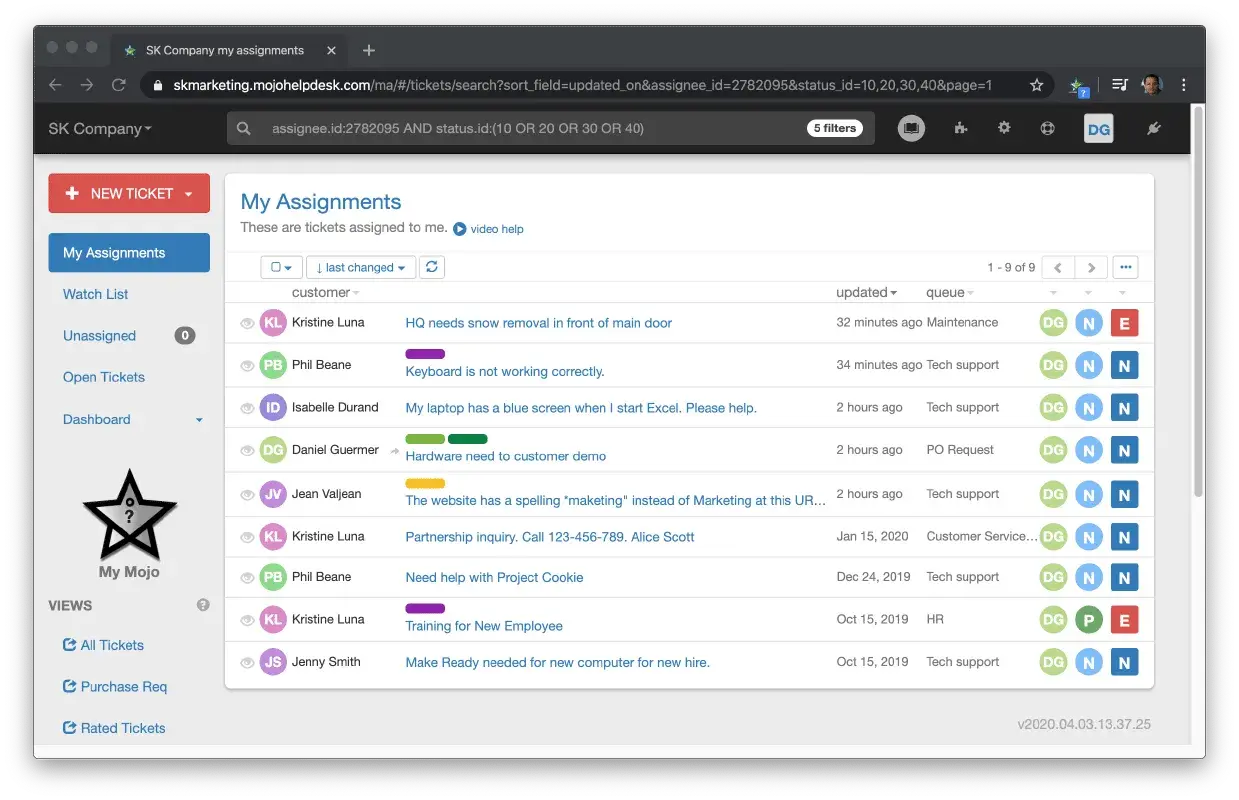
Best for: Small- to medium-sized businesses that want a cost-effective ticketing system and don’t require sophisticated reporting metrics.
What I like: Mojo integrates with G-Suite apps, making linking your Google domain with your help desk easy.
Pricing:
- Team: $14/user/month
- Business: $24/user/month
- Enterprise: $34/user/month
Mojo IT Helpdesk gives you all the tools you need to provide IT support to your employees at a reasonable cost. Mojo includes many top features you expect to see in an internal help desk solution, such as:
- Internal knowledge base.
- Automation of repetitive tasks.
- Asset management (for company laptops and other items).
I explored Mojo IT Helpdesk in a demo and enjoyed the UI of the shared inbox. I also found the Google integration to be simple and effective. After using the product, I saw how Mojo IT Helpdesk would be an excellent solution for a small company transitioning to an internal IT helpdesk.
8. Freshservice
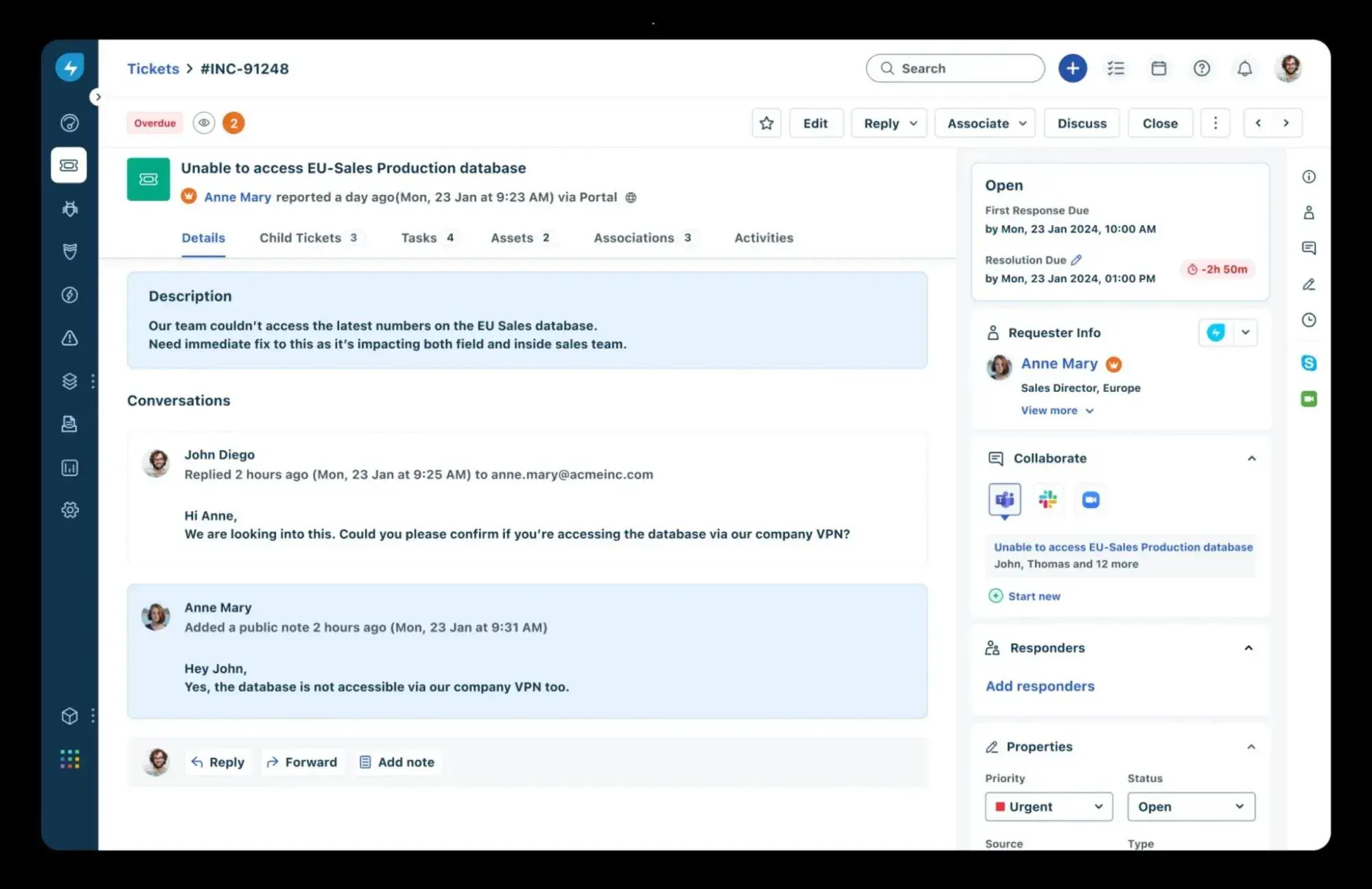
Best for: Large enterprises that need internal support with advanced features.
What I like: Freshservice has a gamification angle for resolving tickets, rewarding agents with points for task completion. I didn’t experience any direct gamification of tickets when I was a support rep, but if this feature existed during my time, I think it would have given the team and me even more of a kick in the pants.
Pricing:
- Starter: $19/user/month
- Growth: $49/user/month
- Pro: $95/user/month
- Enterprise: $119/user/month
Freshservice by Freshworks is a cloud-based ITSM service desk built to help support teams provide timely IT services. This includes incident management, SLA management, asset management, and self-service options.
The Freshservice dashboard displays a comprehensive view of team performance and helps you pinpoint opportunities to improve your service. Freshservice is known for its easy-to-use, intuitive interface, which I can vouch for after my brief product demo.
Like most competitors, Freshservice is using AI technology to supercharge its internal service desk offering. The company has built-in AI (named Freddy) throughout the product to help automate routine queries and enable self-service.
9. Spiceworks Cloud Help Desk

Best for: Small businesses looking for a free (yet capable) internal help desk solution.
What I like: The price! It doesn’t get much better than free.
Pricing: Free!
Spiceworks Cloud Help Desk is a free internal ticketing system that maintains and organizes a centralized portal for all employee-submitted IT tickets. It also features automatic ticket routing and assignment, a knowledge base, a mobile app, and advanced reporting features.
You might wonder how Spiceworks can offer all these features for free, especially given that other companies offer similar products for a pretty penny. I wondered the same thing until I poked around the product during my demo.
Spiceworks’ interface is decidedly sparse and lacks the sleek design and pretty colors of more expensive alternatives. You’ll also notice banner ads in the product's header and sidebar.
While it might not be the easiest to look at, I’d say that's a reasonable price to pay for no price at all — and that’s not to say that Spiceworks can’t hang with the rest of them from a features perspective because you absolutely can run an effective internal IT help desk with Spiceworks.
10. Vision Helpdesk
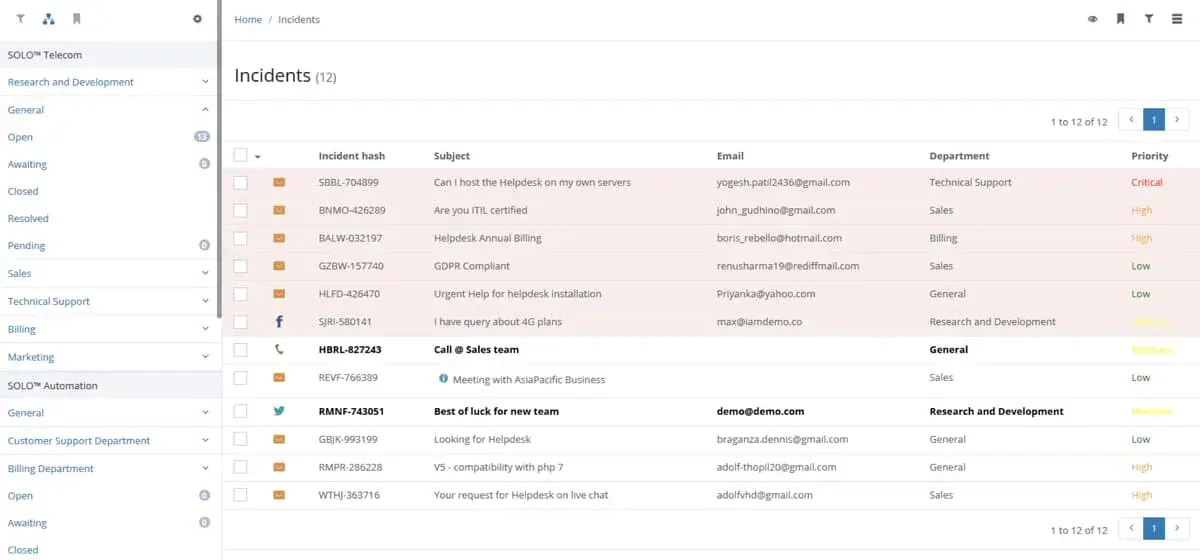
Best for: Businesses of all sizes looking for a flexible and scalable internal ticketing system solution.
What I like: Vision can handle complex support environments involving multiple departments and brands within a single installation. SLA support ensures that tickets are resolved in a timely fashion. Vision’s reporting features are also top-class.
Price:
- Pro: $32/user/month
- Enterprise: $48/user/month
I like Vision Helpdesk because it enables agents to collaborate directly in the platform, gamify daily tasks, and manage projects effectively with task management tools—helping teams stay on schedule and improve performance. IT asset management features let you manage and track the lifecycle of IT assets like laptops, monitors, and other hardware, while knowledge base management features allow you to build a multi-level categorized self-service portal so employees can save themselves (and you) time from dealing with common inquiries and issues.
11. Giva
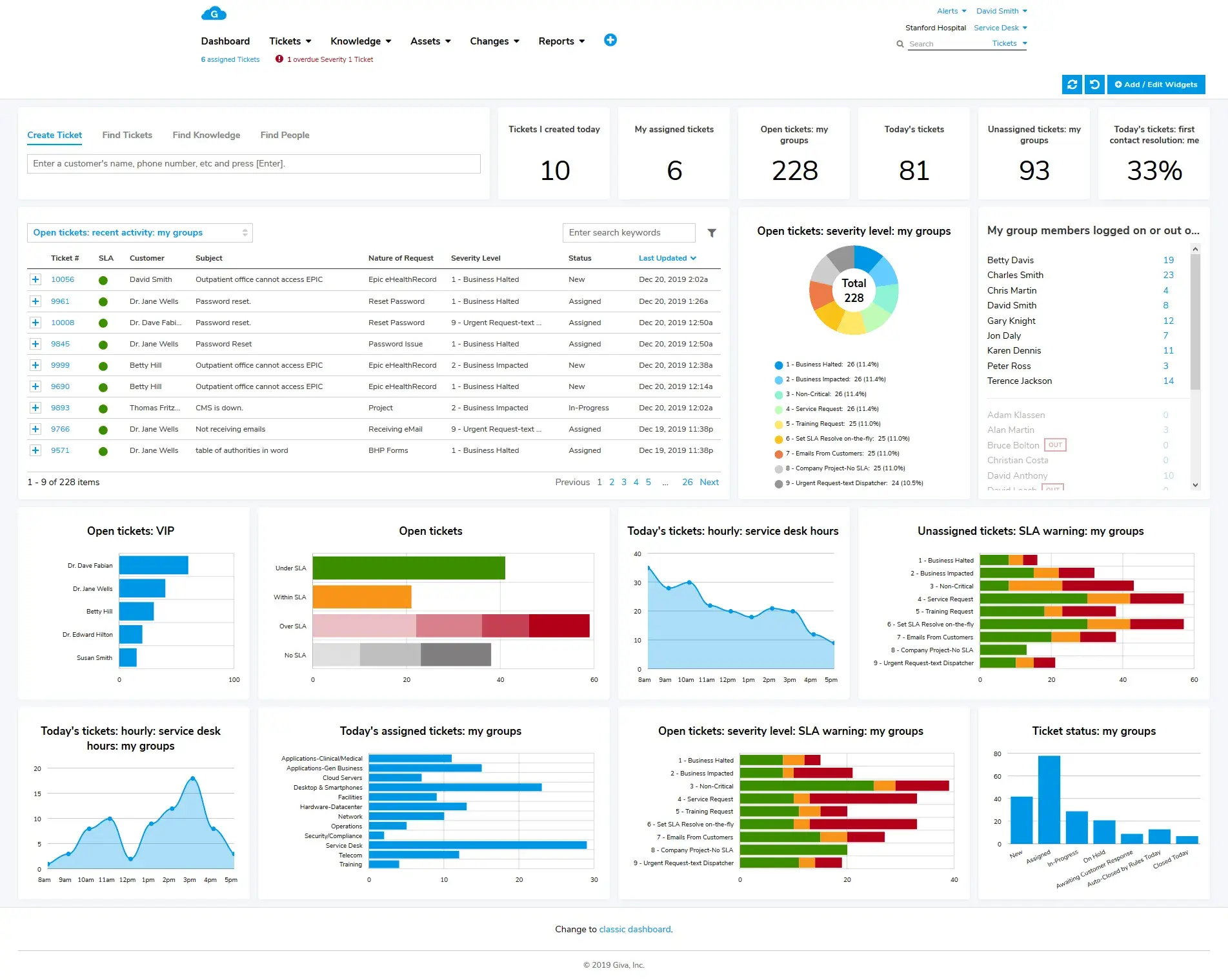
Best for: Healthcare organizations that require HIPAA compliance with exceptional security.
What I like: Giva’s homepage dashboard is very customizable. It features drag-and-drop resizable modules with a clean, minimalist look.
Price:
- Professional: $59/user/month
- Enterprise: $79/user/month
Giva provides a functional internal IT help desk solution with competitive AI-powered features and advanced reporting and analytics capabilities. It prioritizes data security with HIPAA, HITECH, and GDPR compliance, making it a popular choice for healthcare, law, finance, and other high-security-minded organizations. I was impressed with Giva’s homepage, which allows you to customize a dashboard with the most relevant charts and metrics for your organization.
12. ServiceDesk Plus
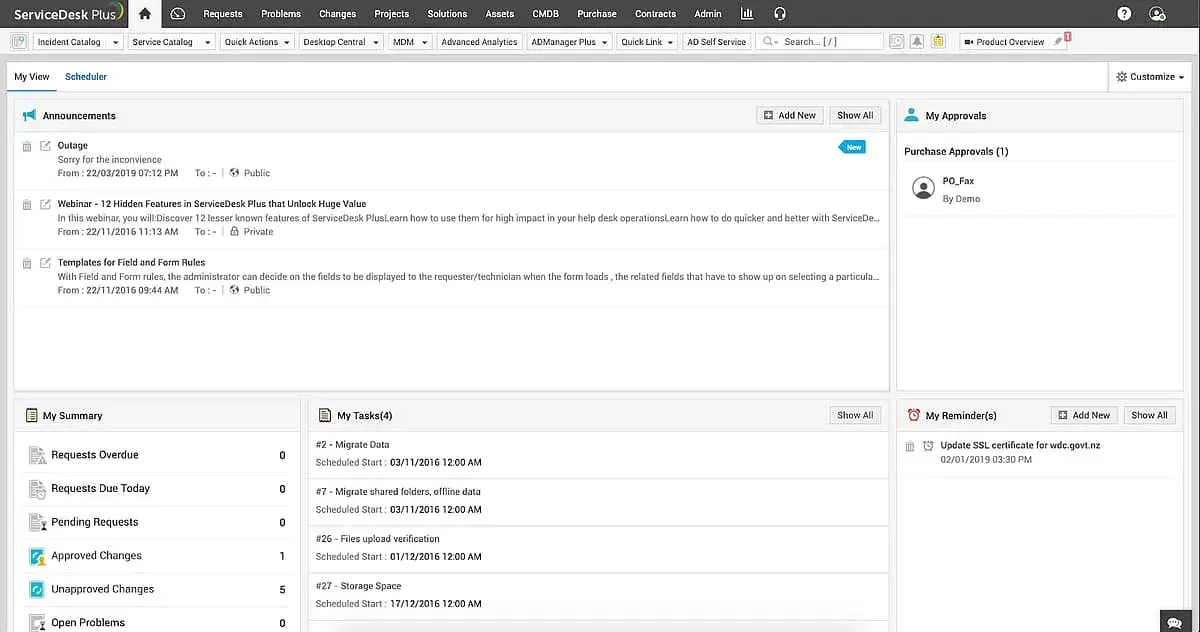
Best for: Large enterprises that need helpdesk software with ITIL (Information Technology Infrastructure Library) processes built in.
What I like: ServiceDesk’s automatic ticket dispatch feature distributes new tickets to service representatives based on their existing ticket load. As a former support rep, I think this feature is valuable for managing workload and gives support management one less thing to worry about.
Pricing: Available upon request.
ServiceDesk Plus is an advanced IT ticketing system that can be used in the cloud or installed on-premises. It also offers large IT teams the flexibility to purchase add-ons for live chat, incident management, change management, asset management, and project management.
ServiceDesk Plus‘s premium plans let agents provide customers with real-time solutions via remote access to the client’s desktop, which, in my experience, is a valuable feature for tricky problems when email or phone support doesn’t provide enough clarity.
13. TOPdesk
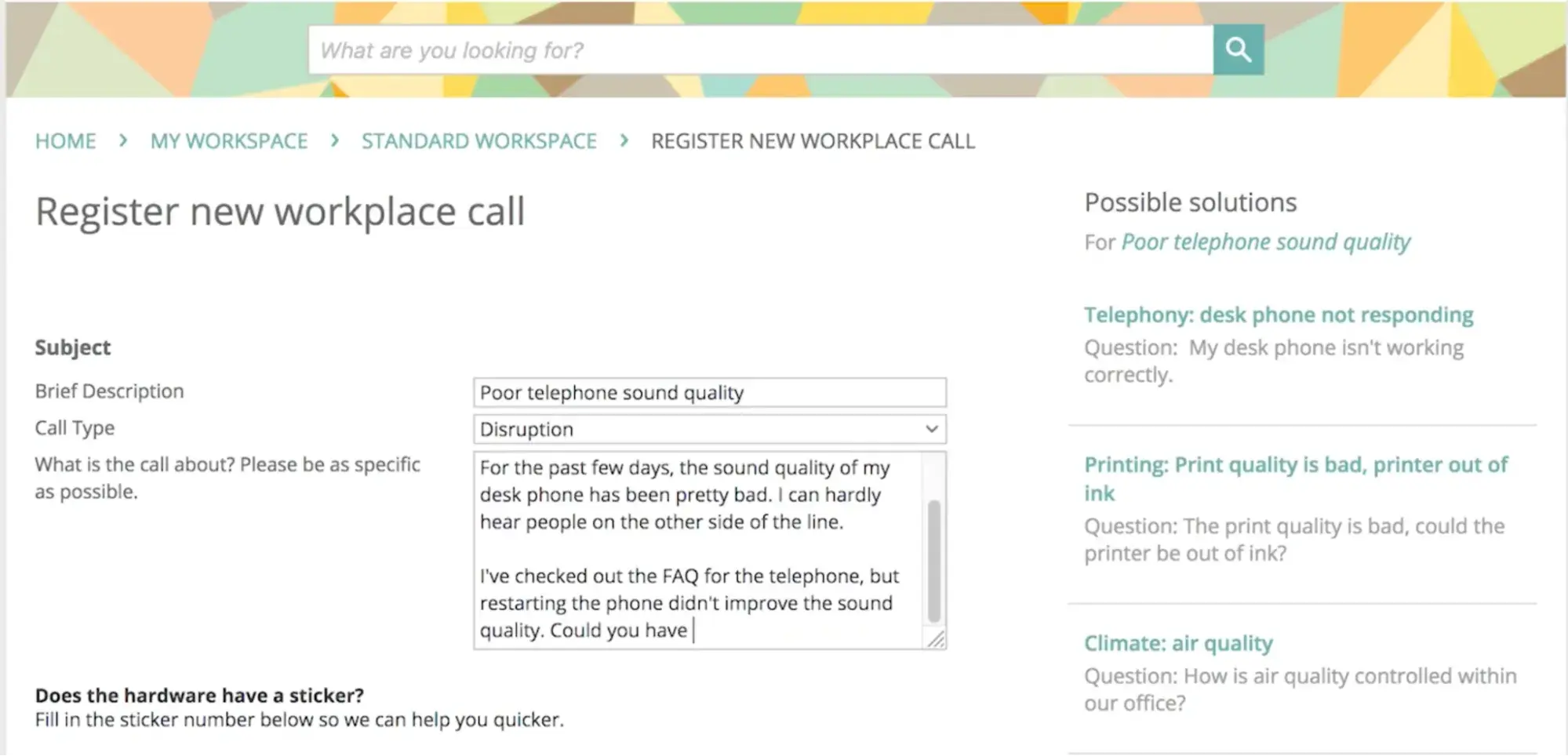
Best for: Small- to medium-sized companies seeking an easy-to-use internal help desk that can be deployed quickly.
What I like: TOPdesk’s self-service portal provides users with a one-stop-shop for submitting and tracking IT support requests.
Pricing: Available upon request.
TOPdesk is a cloud-based IT service management solution that offers incident management features for tracking support requests, an easy-to-use self-service portal, knowledge base, and IT asset management. I checked out a trial of TOPdesk and found it to be competitive with other options regarding available features. However, I thought the UI was a bit dull compared to other options on this list.
14. Atera
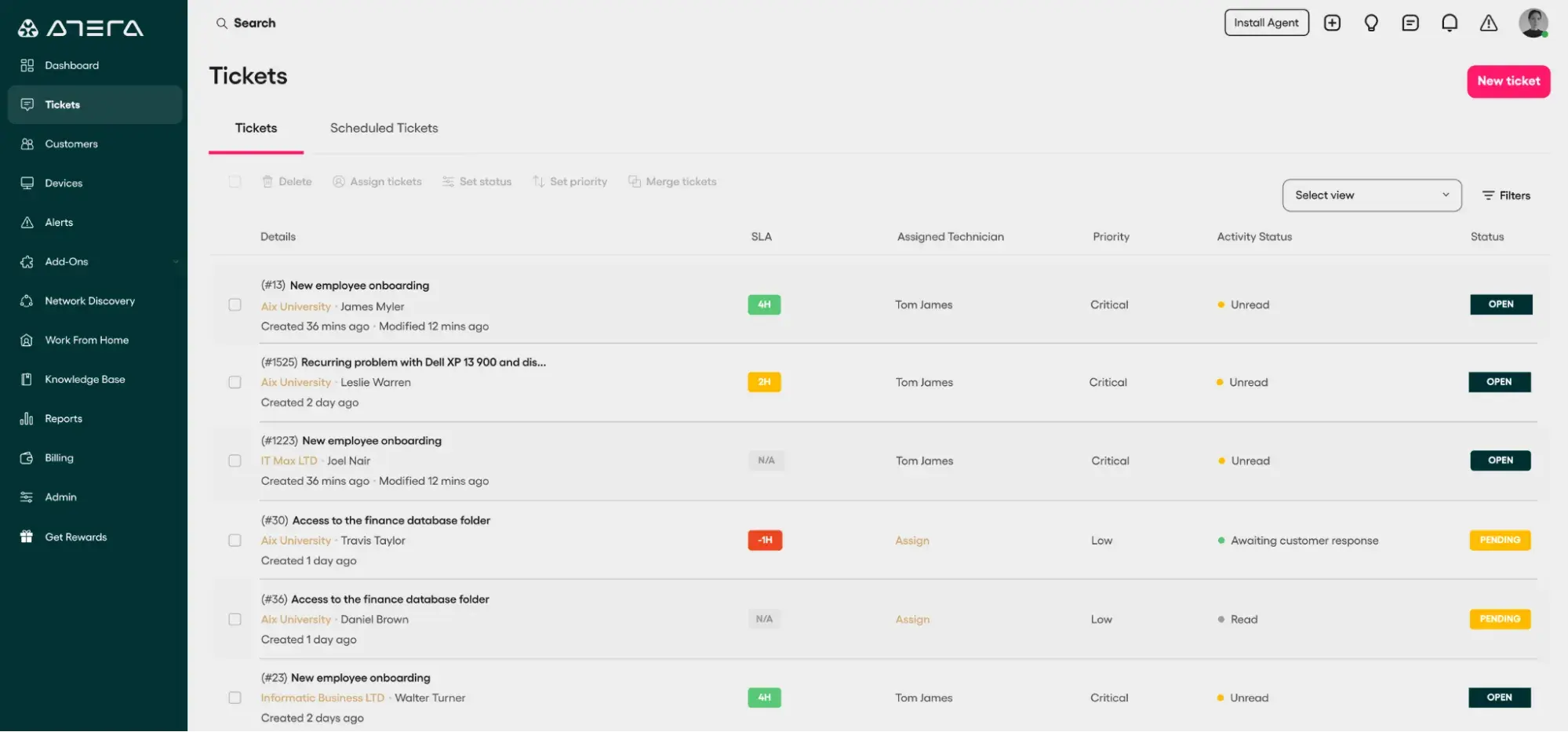
Best for: Medium to large organizations seeking an all-encompassing IT ticketing system and management solution.
What I like: I demoed Atera and was impressed with the AI-powered assistant feature that could auto-solve tickets, auto-generate responses, gauge user sentiment, and translate plain-language descriptions into terminal command prompts.
Pricing:
- Professional: $149/user/month
- Expert: $189/user/month
- Master: $219/user/month
- Enterprise: pricing available upon request
Atera is an all-in-one solution for IT departments that offers help desk capabilities, remote monitoring and management of IT assets, and robust reporting capabilities. Atera is expensive, but I think the saying “you get what you pay for” applies here. Many internal ticketing systems offer AI-powered features, but Atera’s are exceptionally robust.
15. ServiceNow
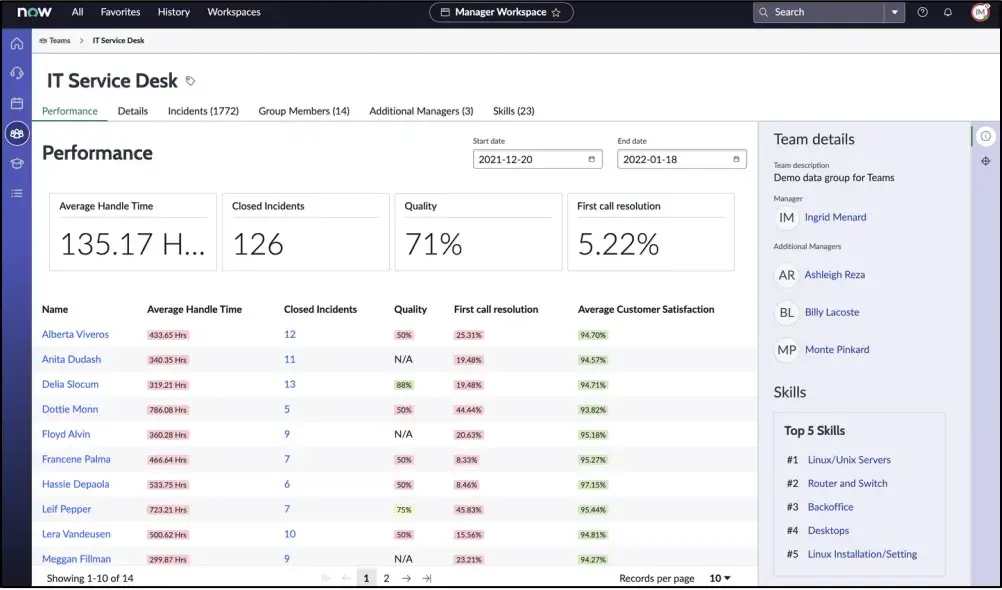
Best for: Large enterprises seeking a robust IT services management platform with AI and automation features.
What I like: ServiceNow’s AI-powered virtual agent chatbot can significantly reduce IT agent workloads by automatically solving simple requests and intelligently escalating others.
Pricing: Available upon request.
ServiceNow is an enterprise-level ITSM tool with robust features. It is a scalable solution known for its AI-driven insights and easily configurable automated workflows. In my demo, I found the AI-powered virtual agent chatbot to be particularly powerful yet simple to configure with a drag-and-drop interface for if/then style workflows.
Whether you‘re looking for an on-premises solution or a cloud-based service desk, you’re bound to find the right IT ticketing system software that fits your business's needs.
Now, let's look at a few more tools that IT professionals use every day.
Best IT Support Software
1. CCleaner
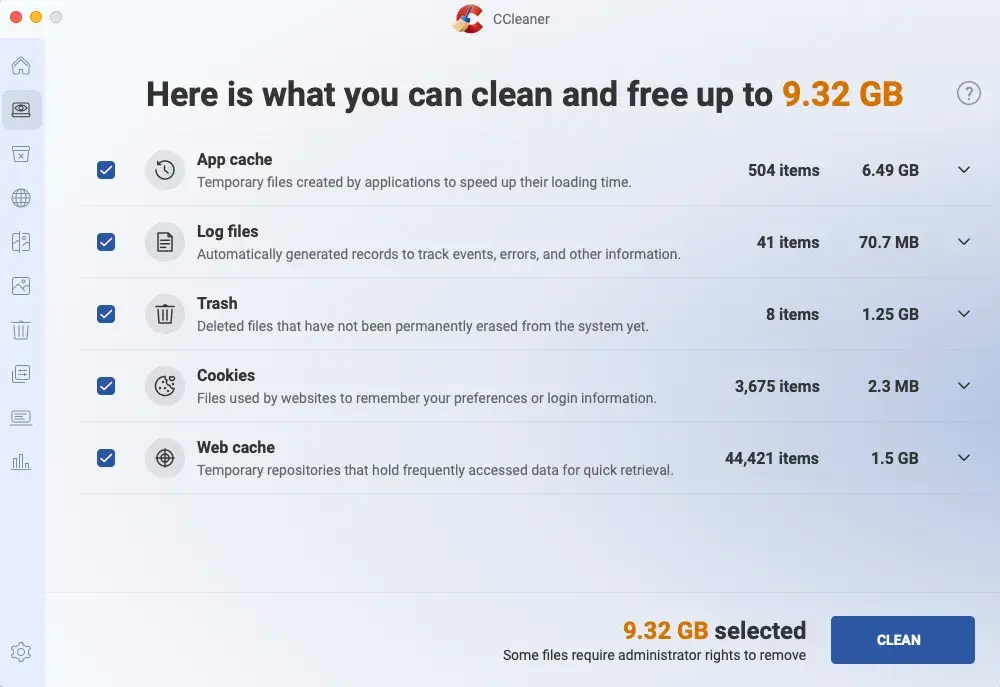
Best for: IT managers at small/medium-sized businesses looking to automate the service of 5+ PCs.
What I like: CCleaner’s scheduling feature allows teams to set up convenient cleaning times that don’t interfere with business.
Pricing:
- Free download
- Business: $2/PC/month
CCleaner is like the maintenance person for your IT system. It clears old files your software doesn‘t use and frees up space on your hard drive so your other apps can operate faster. With its routine maintenance checks and repairs, CCleaner ensures your team isn’t hindered by slow operating speeds, especially as your customer base grows. It’s worth noting that the CCleaner Cloud business offering can only manage Windows PCs.
I downloaded the free version of CCleaner for my laptop and was able to free up almost 10 GB of disc space in a matter of moments! It can also intelligently uninstall apps and scan your computer for duplicate files that do nothing but take up valuable hard drive space.
2. Foxit PDF Editor
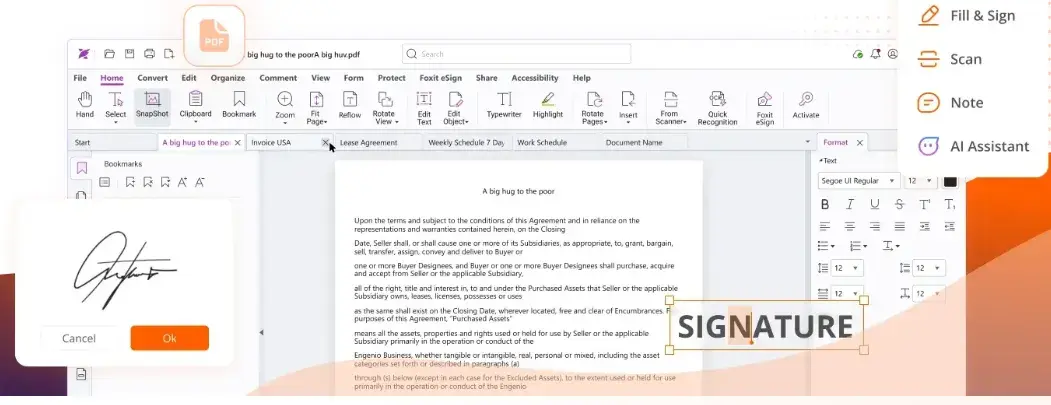
Best for: Businesses looking for a powerful PDF editing solution that goes beyond the capabilities of native PDF software.
What I like: Foxit’s security features provide a layer of protection, especially when downloading files from unknown sources.
Pricing:
- PDF Editor: $129.99/year
- PDF Editor+: $159.99/year
Foxit’s PDF editor offers robust editing capabilities, optical character recognition (OCR), form creation and editing, document collaboration, and advanced security features. At first, I was skeptical about the need for PDF software beyond those built into macOS and Windows. However, upon trialing Foxit, it was clear that the product offers additional value and features not found in these solutions.
3. Recuva
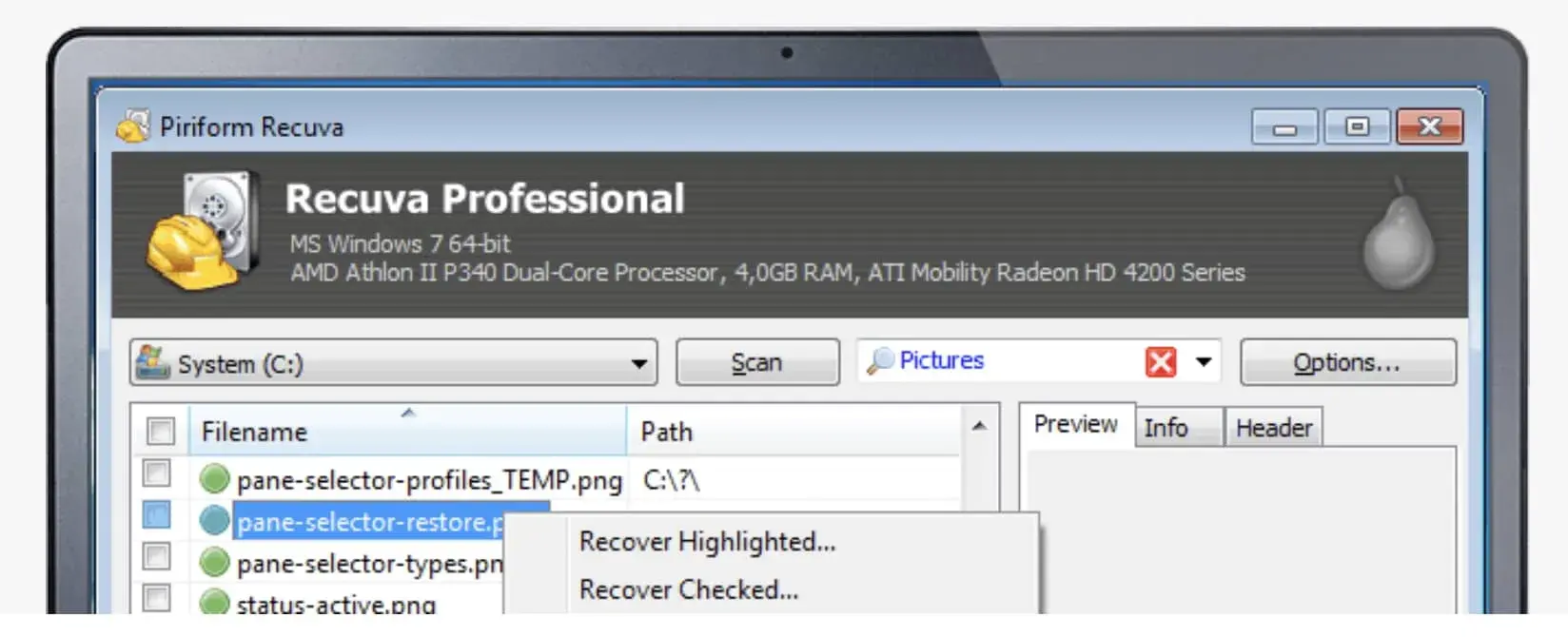
Best for: Anyone looking for a safe and reliable way to recover files.
What I like: The Wizard interface is easy to use. It allows users to quickly select the type of files they’re trying to recover and from where, which cuts down the time it takes to scan.
Pricing:
- Free download
- Professional: $24.95/year
We all have had that moment when we accidentally clicked “delete” and thought we lost a file forever. Fortunately, Recuva can recover any accidentally deleted files, saving you a ton of headaches.
Recuva also has an advanced scanning tool, which can help you find files that were lost a long time ago or after a computer crash.
4. LastPass Password Manager
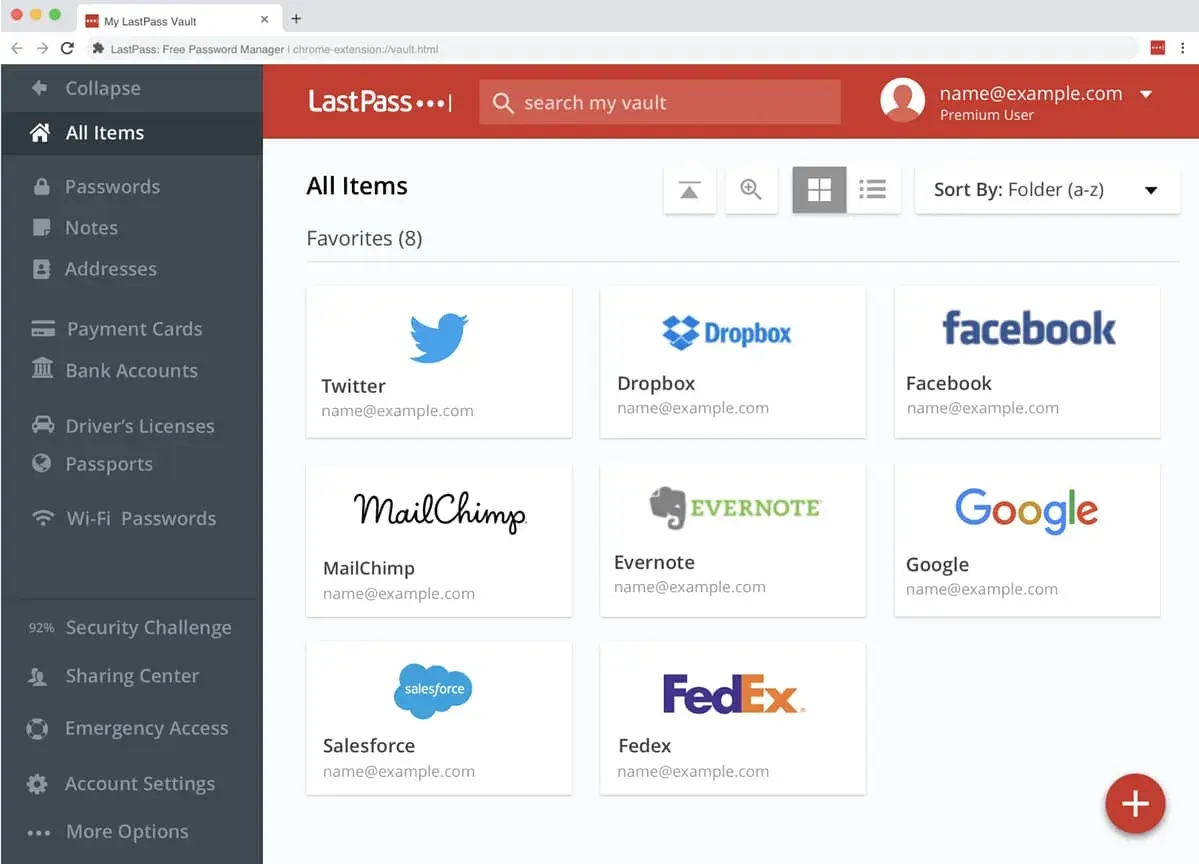
Best for: Small and large companies that need password management assistance.
What I like: LastPass automatically generates strong and secure passwords, so you don't have to remember all of them or write them down.
Pricing:
- Free plan available
- Teams: $4/user/month
- Business: $7/user/month
LastPass is like a universal remote for your apps and software. Rather than remembering a password for each tool your team uses, LastPass stores and fills in password credentials automatically. While your software is still secured by unique codes and encryptions, LastPass simply reduces the time your employees spend logging in and out of apps.
I use LastPass myself, and my favorite feature is the automatic secure password generator. Nothing makes me feel at ease like signing up for a new online account with an unguessable password like UhN**c9)7h^@1 and not needing to remember it myself.
5. Dropbox

Best for: Large teams looking to consolidate files securely without hindering collaboration.
What I like: Dropbox offers document scanning and signing features that intuitively integrate with its file storage solution.
Pricing:
- Standard: $15/user/month
- Advanced: $24/user/month
- Enterprise: Custom pricing based on business requirements
Dropbox is a top-rated cloud storage and file-sharing tool. It creates a communal space where employees can upload and view documents their team or upper management created. As more documentation is uploaded, Dropbox acts as an internal knowledge base, providing employees with informative resources and data about your business.
Dropbox offers the highest level of data security, numerous integrations, and advanced admin controls to allow IT teams to manage users and monitor activity.
6. Microsoft Attack Surface Analyzer
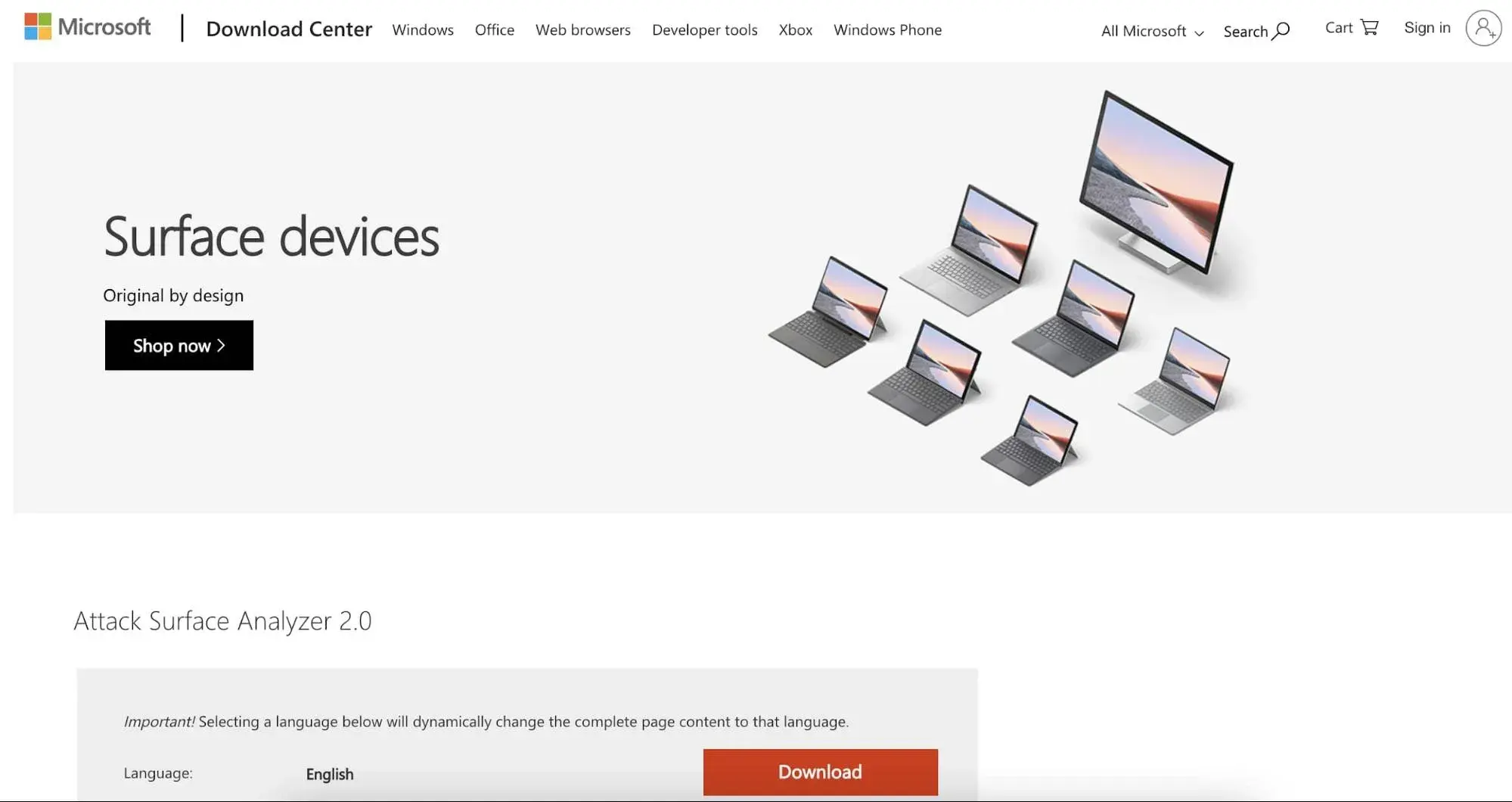
Best for: Security-minded IT professionals.
What I like: Microsoft Attack Surface Analyzer highlights any changes that could introduce security vulnerabilities.
Pricing:
- Free download
At the enterprise level, you can never be too secure. Microsoft Attack Surface Analyzer is a tool meant to help businesses maintain and improve the security of all their systems by analyzing any changes made when introducing new software. Surface Analyzer can spot any potential threats before they have the opportunity to do any damage.
7. Zapier
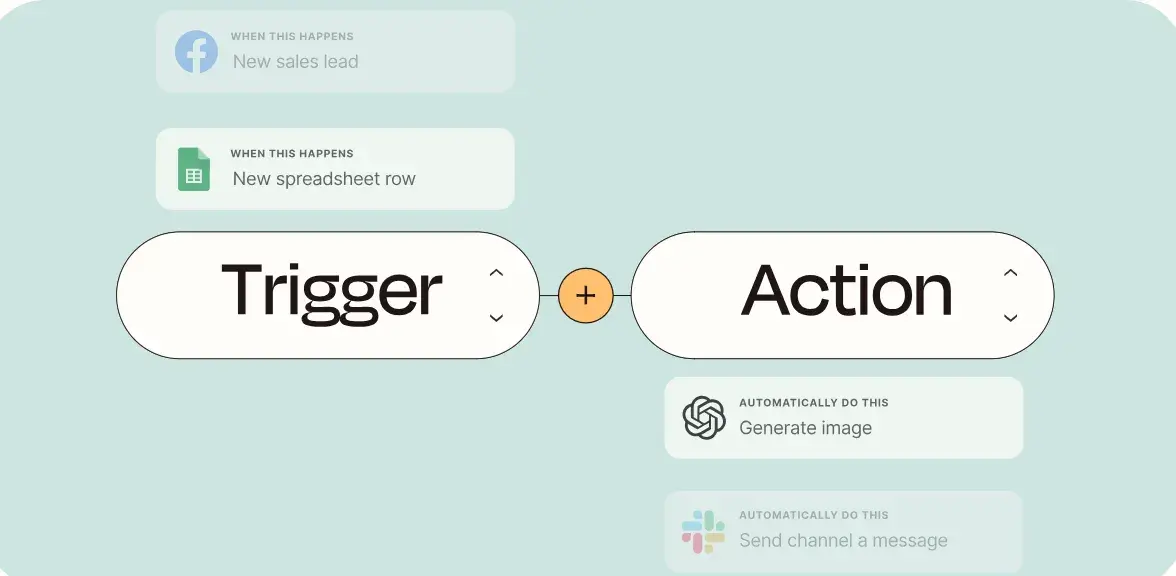
Best for: Everyone, from individuals to large enterprises, who needs to automate workflows and share data between disparate applications.
What I like: Zapier’s drag-and-drop interface is very intuitive. No coding required!
Pricing:
- Free plan available
- Professional: $19.99/month
- Team: $69/month
- Enterprise: Pricing upon request
Most businesses today use a variety of separate applications for different tasks, such as email blasts, website management, file sharing, CRM, etc. The issue is that these apps aren’t connected, so if you update a record in one place, it doesn’t update everywhere else.
Zapier fixes that by linking your software with “zaps,” allowing you to create custom triggers in one app that lead to a corresponding action in another. I love that Zapier offers thousands of pre-made zaps to tackle everyday business use cases.
8. Icecream Screen Recorder
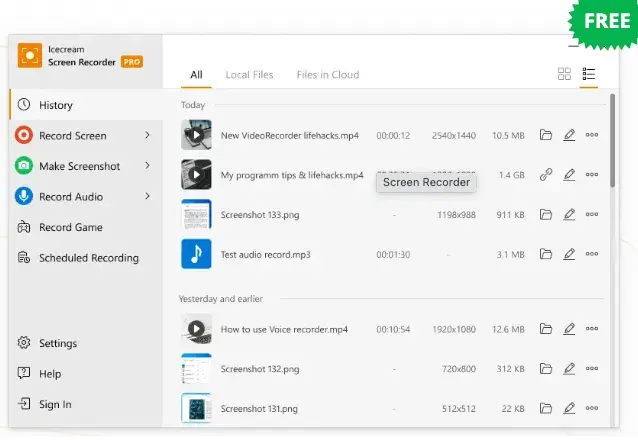
Best for: IT teams needing an easy way to troubleshoot and explain issues via video.
What I like: Icecream isn’t limited to screen recording. It can also capture audio and support annotation.
Pricing:
- Free plan available
- Pro: $29.95/yr or $59.95 for a lifetime license
Icecream is a free screen recording application that allows users to quickly capture a recording of their computer screen, annotate it, and share it. This is extremely useful for end users and IT professionals when troubleshooting and explaining issues when text/voice correspondence just isn’t cutting it.
When I worked as a support representative, I used a screen recording tool to send clips of myself demonstrating tasks or showing customers where to locate a specific feature or button. Sometimes, it’s a lot easier to show than to tell.
Screen recording is also valuable for end users who want to show IT examples of bugs or other unexpected software behavior for much quicker analysis than describing the issue in words.
Internal Ticketing System Benefits
Using an internal IT ticketing system will simplify and streamline your day-to-day tasks, freeing up time for you to work on more critical tasks. Benefits of switching include:
- Tracks everything in one place: Using an internal ticketing system consolidates all your IT support assets in one place. No more chasing down emails in one place and messages in another. You’ll have a record of all your IT support interactions stored in the same system.
- Automates task management: Automating specific tasks will save you time and prove invaluable when dealing with many inquiries. You can set up automatic responses, ticket assignments, and triage with just a few clicks. Automation will also help you prioritize the tickets and tasks that need your attention most.
- Reporting tools built in: Improving your internal IT service experience is difficult when you don’t have a way to measure it. The reporting tools that come with IT ticketing systems can ensure you’re upholding SLA expectations and standards. You can also track your response times, how many tickets are resolved within a set time frame, identify pain points, and more to keep a pulse on agent performance.
- Enables team collaboration: An internal ticketing system can also increase collaboration between IT support agents and other stakeholders. Easily and quickly assign someone on your team a ticket, get help resolving an issue, and make real-time changes.
- User-Satisfaction: An internal help desk will improve employee satisfaction and morale, as users can get the IT support they need more quickly and efficiently.
Improve Support With Internal Help Desk Software
Help desk software and internal IT tools can make your internal service and support teams more efficient and effective in resolving challenges, collaborating, and providing a delightful experience.
After my deep dive into internal help desk software, my biggest takeaway is the concept that your employees are customers, too, in a sense. As a former support rep, I’m familiar with the ins and outs of ticketing systems and how important they are to providing consistent, high-quality support. What I hadn’t considered until exploring internal help desk options is that the same concept applies to your employees.
I choose to take a holistic view of business. Providing high-quality IT support to your internal teams improves the health of the organization overall, ultimately resulting in an improved ability to serve and satisfy external customers.
Editor's note: This post was originally published in June 2019 and has been updated for comprehensiveness.
.webp?width=112&height=112&name=Help-Desk-EN@3x%20(1).webp)

.webp)
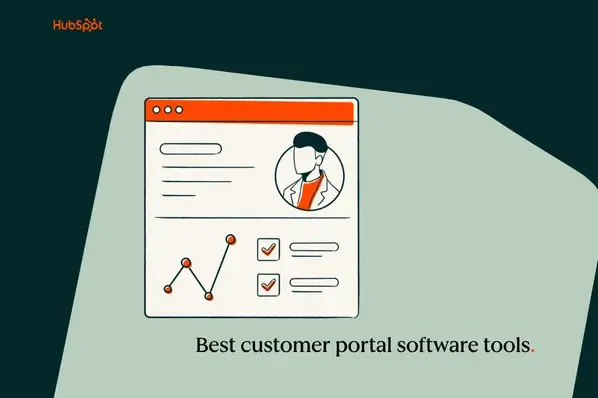
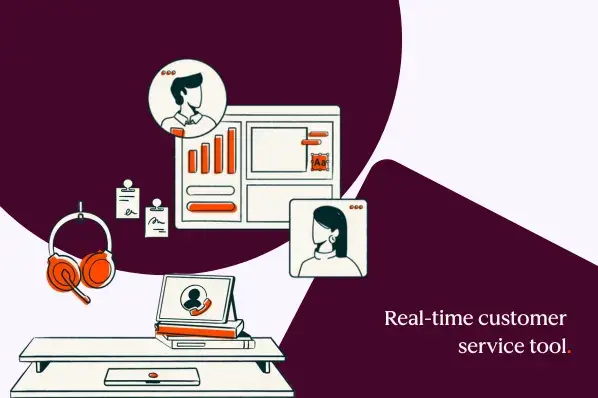
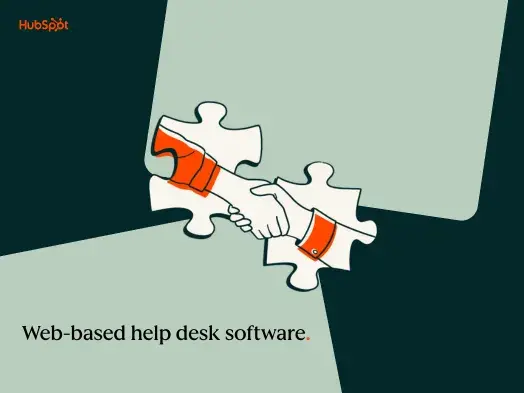






.png)